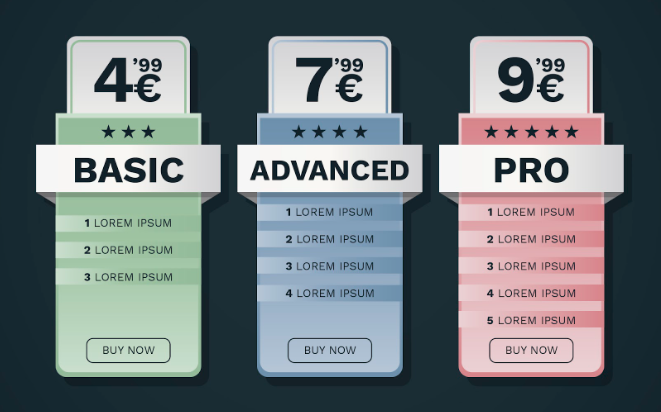How Tiered Subscriptions Convert More Users & Boost Revenue
Insights and Strategies from the Dating App Space
In the ever-evolving app marketplace, businesses are constantly looking for ways to drive user engagement and boost revenue. While traditional subscription models have long been the standard, the introduction of tiered pricing has proven to be a game-changer, capable of increasing conversion rates, improving retention, and driving sustainable growth.

Why Tiered Subscriptions Work
1️⃣ Catering to Different User Segments
One of the primary advantages of tiered subscriptions is the ability to cater to different user segments. In a world where personalization is key, a tiered model allows you to appeal to both budget-conscious users and those willing to pay for premium features. This structure isn't unique to dating apps – it's widely used across industries. In the context of dating apps, a lower-tier plan might include basic features like unlimited swipes or the ability to view incoming likes, while higher-tier subscriptions can unlock advanced perks such as boosted profile visibility, more matches, or exclusive access to matchmaking algorithms.
Some users may be hesitant to commit to a full-priced premium plan, especially if they are unsure about the app's value. Offering a more affordable entry-level subscription removes this friction, giving users a chance to experience the app at a lower cost, with the potential to upgrade as they see value in the service. On the other hand, power users who are invested in the app will appreciate the enhanced features of a higher-tier plan, which justifies a higher price point.
2️⃣ Reducing Decision Friction
Another benefit of tiered pricing is that it reduces decision friction. When users are presented with a simple choice – free versus premium – it can feel overwhelming, especially if they're not interested in all the features offered in the full package. In that case, the decision becomes all or nothing. Tiered plans offer a more flexible path, allowing users to try premium at a lower commitment before upgrading further.
In dating apps, this is particularly impactful. Users who are just starting out may feel unsure about spending too much money upfront. A lower-tier option allows them to explore the platform without a heavy financial commitment. At the same time, users who are more serious about their search for a partner can opt for a higher-tier plan with enhanced features, ensuring they feel that their investment is worthwhile.
3️⃣ Driving Upsells & Revenue Growth
Perhaps the most significant benefit of tiered subscriptions is the ability to drive upsells. By offering multiple pricing tiers, businesses can capture a wider range of users. Many users will start with a lower-tier plan and, over time, as they begin to see the value of the app, they will upgrade to a higher tier. This process of gradual upselling helps to maximize lifetime value (LTV) for each user.
A great example of this is Duolingo. Users can start with a free version or a low-cost Super Duolingo subscription, and as they become more engaged, they're introduced to higher-tier options like Duolingo Max with AI-powered feedback. This progression supports long-term revenue growth through incremental upsells.
In the case of dating apps, users often begin with basic features but will upgrade to higher-tier plans as they become more engaged with the platform. These higher-tier plans can include access to exclusive content, additional features, or even personalized matchmaking services. As users experience more of what the app has to offer, they are likely to see the benefit of these additional features, thus driving further revenue growth for the business.
The Impact on Key Metrics
Implementing tiered subscriptions can have a significant impact on key business metrics, such as conversion rates, revenue, and retention.
✅ Conversion: A well-structured tiered pricing model increases conversion rates by offering users multiple options at different price points. By lowering the initial cost barrier, more users are likely to sign up and pay for a premium subscription. Once they are invested in the app, many will upgrade to a higher-tier plan as they see its value.
In products I'm working on, introducing tiered pricing led to an 18% increase in subscription conversion within the first quarter.
✅ Revenue: A higher-tier subscription plan with exclusive features allows businesses to monetize power users – those who are more engaged and willing to pay more. This allows businesses to capture a larger share of revenue from users who are invested in the app and looking for advanced features. Dating apps, for instance, often offer exclusive perks such as profile boosts, access to premium matches, or AI-powered matchmaking algorithms, all of which can drive revenue growth.
Our team saw a 25% uplift in overall subscription revenue after rolling out a multi-tier pricing model, demonstrating the effectiveness of aligning product value with user willingness to pay.
✅ Retention: Another key advantage of tiered subscriptions is improved user retention. Rather than forcing users to churn because they can't or don't want to commit to the full premium subscription, they can downgrade to a lower-tier plan and continue engaging with the app. This flexibility keeps users active for several reasons beyond affordability: their needs may shift temporarily (e.g., reduced app usage or being in a relationship), they may want to reassess the value they're getting, or they might feel overloaded by advanced features and prefer a simpler experience. Additionally, users who subscribed during a promotion might choose to stay on a lower plan once the offer ends. By providing a softer landing, tiered pricing increases the chances that users will remain engaged – and potentially upgrade again in the future.
In our case, monthly active subscriber retention increased by 10% after we introduced a medium-tier plan that better fit users who weren't ready to pay for the full package or didn't need all the premium features. This new segment ended up being more stable and engaged than expected, helping push our overall subscriber retention rate to 40%.
Real-World Examples
Several successful companies have leveraged tiered pricing models to optimize revenue and engagement. Spotify and Headspace offer tiered subscription plans that serve a wide range of user needs – from casual users to highly engaged power users.
In the dating app space, this model takes on added significance due to the highly personal and intent-driven nature of user behavior. While basic functionality may attract casual users, many platforms go further by layering in premium features that appeal to users at different stages of their dating journey.
For example, Tinder offers multiple premium plans (Plus, Gold, and Platinum) each unlocking additional functionality such as seeing who liked you, unlimited swipes, and priority likes. Similarly, Bumble's tiered offerings cater to users who want everything from profile boosts to travel features and advanced filters.
Beyond just generating revenue, these tiers also serve as a mechanism to personalize the dating experience, allowing users to tailor their experience based on their goals – whether that's browsing casually, dating seriously, or building connections abroad. This blend of monetization and personalization is what makes tiered pricing not only profitable but essential in the dating space.
Conclusion
Tiered subscription pricing has become a proven strategy for apps aiming to balance user engagement with sustainable growth. By moving beyond a one-size-fits-all model, it allows businesses to meet users where they are, whether they're testing the waters or fully invested in the product.
This approach is particularly effective for apps with diverse user bases and varying levels of intent. In spaces like dating, where user goals range from casual browsing to serious connections, tiered pricing creates room for choice, flexibility, and long-term retention.
When implemented thoughtfully, it doesn't just drive revenue – it gives users more reasons to stay.
Have you tried tiered pricing in your product? I'd love to hear what worked (or didn't) in your experience.

About the Author
Maiia Vladimirova
I am an experienced product manager with a background in the mobile app and dating app industries. I specialize in user experience, monetization strategies, and subscription models, helping businesses optimize revenue and user engagement.
Feel free to connect with me on LinkedIn if you'd like to chat or exchange ideas!